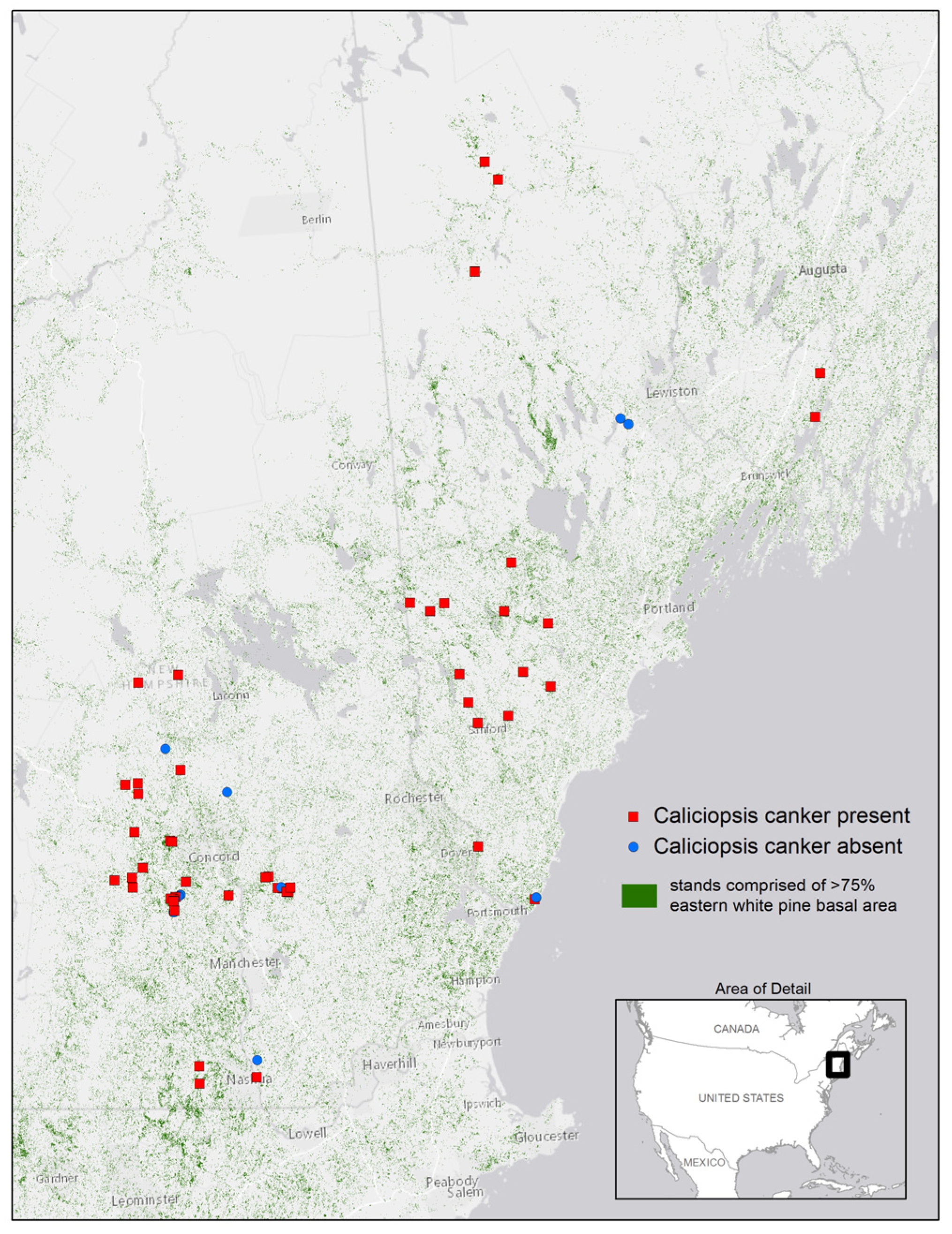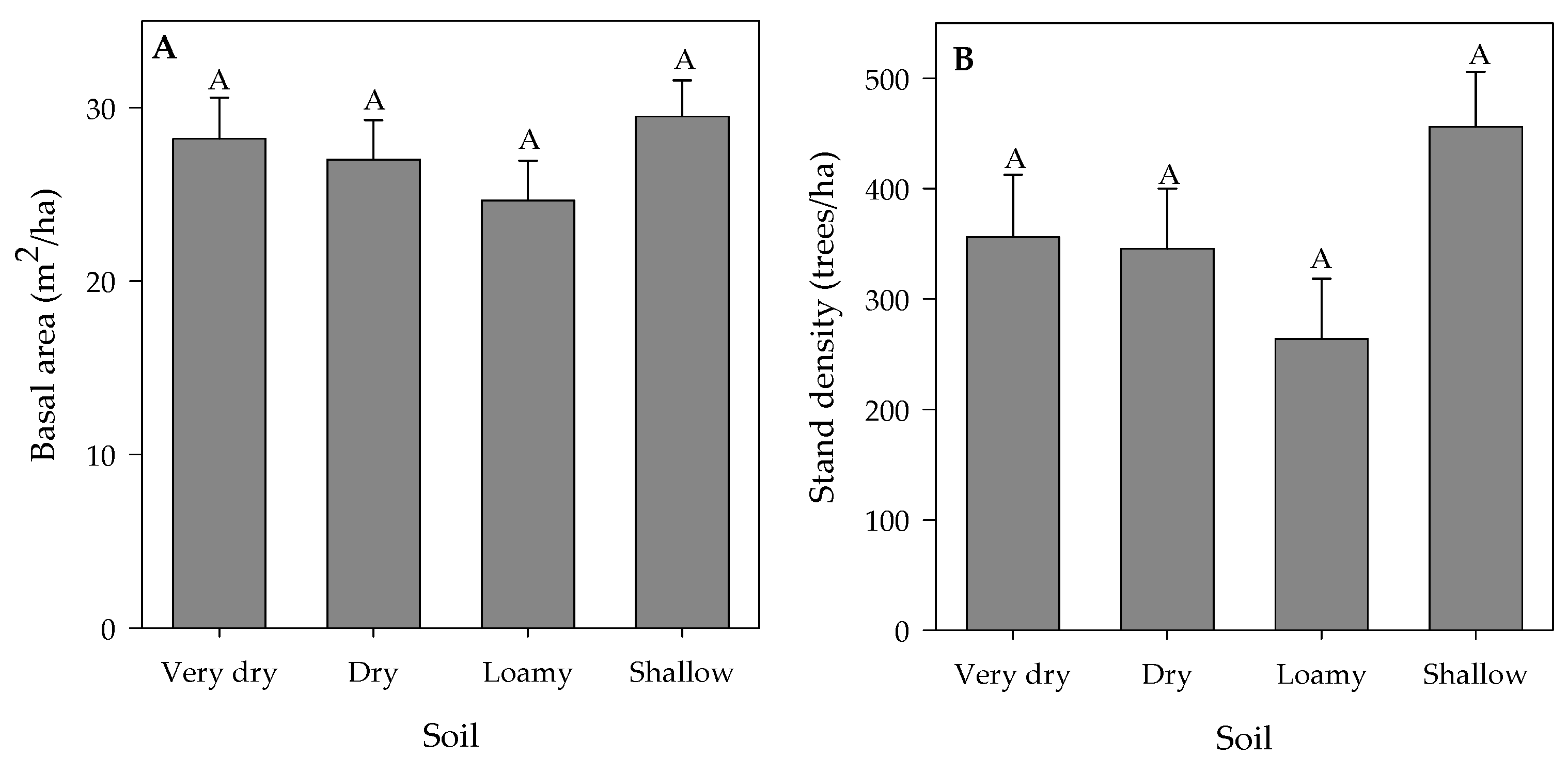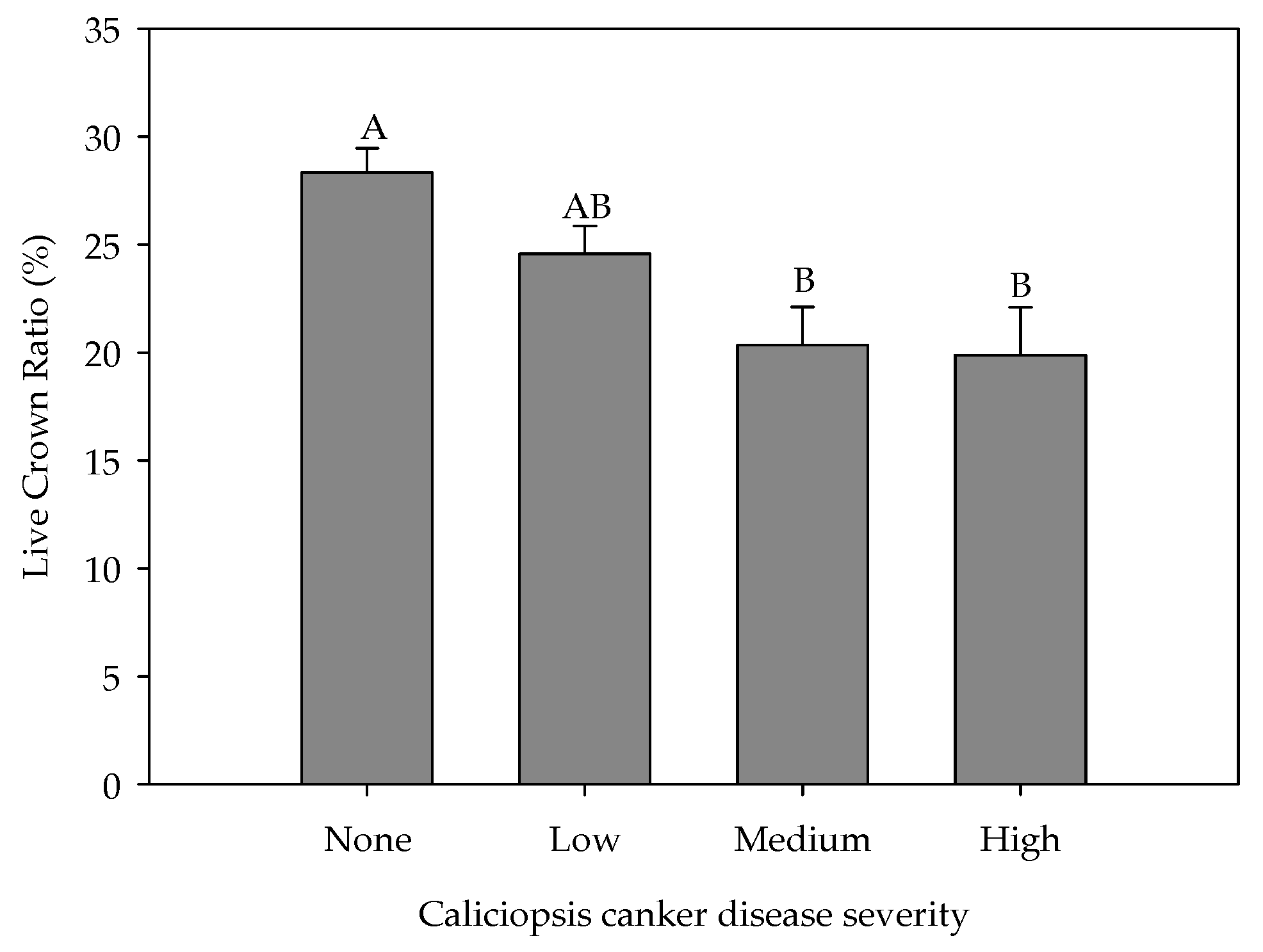Soil and Stocking Effects on Caliciopsis Canker of Pinus strobus L.
Abstract
:1. Introduction
2. Materials and Methods
2.1. Site Selection
2.2. Field Sampling
2.3. Isolation and Identification of Caliciopsis pinea
2.4. Statistical Analyses
3. Results
4. Discussion
5. Conclusions
Acknowledgments
Author Contributions
Conflicts of Interest
References
- North East State Foresters Association. The Economic Importance of Forest-Based Economies of Maine, New Hampshire, New York and Vermont. Available online: http://www.nefainfo.org/uploads/2/7/4/5/27453461/nefa13_econ_importance_summary_aw_feb05.pdf (accessed on 9 March 2016).
- Widmann, R.; McWilliams, W. Managing white pine in a new millennium. In An Overview of the White Pine Resource in New England Using Forest Inventory and Analyses Data; Bennett, K., Desmarais, K., Eds.; University of New Hampshire Cooperative Extention: Hillsborough, NH, USA; pp. 1–8.
- Wendel, G.W.; Smith, H.C. Eastern white pine (Pinus strobus L.). In Silvics of North America, Agriculture Handbook 654; Burns, R.M., Honkala, B.H., Eds.; USDA Forest Service: Washington, DC, USA, 1990; Volume 1, pp. 476–488. [Google Scholar]
- Joyce, D.G.; Rehfeldt, G.E. Climatic niche, ecological genetics, and impact of climate change on eastern white pine (Pinus strobus L.): Guidelines for land managers. For. Ecol. Manag. 2013, 295, 173–192. [Google Scholar] [CrossRef]
- Funk, A. Studies in the genus Caliciopsis. Can. J. Bot. 1963, 41, 530–543. [Google Scholar] [CrossRef]
- Munck, I.; Livingston, W.; Lombard, K.; Luther, T.; Ostrofsky, W.; Weimer, J.; Wyka, S.; Broders, K. Extent and severity of caliciopsis canker in New England, USA: An emerging disease of eastern white pine (Pinus strobus L.). Forests 2015, 6, 4360–4373. [Google Scholar] [CrossRef]
- Mech, A.M.; Asaro, C.; Cram, M.M.; Coyle, D.R.; Gullan, P.J.; Cook, L.G.; Gandhi, K.J.K. Matsucoccus macrocicatrices (hemiptera: Matsucoccidae): First report, distribution, and association with symptomatic eastern white pine in the southeastern United States. J. Econ. Entomol. 2013, 106, 2391–2398. [Google Scholar] [CrossRef]
- Ray, W.W. Pathogenicity and cultural experiments with Caliciopsis pinea. Mycologia 1936, 28, 201–208. [Google Scholar] [CrossRef]
- McCormack, H.W. The morphology and development of Caliciopsis pinea. Mycologia 1936, 28, 188–196. [Google Scholar] [CrossRef]
- Asaro, C. What is killing white pine in the highlands of west Virginia? In Forest Health Review May 2011; Virginia Department of Forestry: Charlottesville, VA, USA, 2011. [Google Scholar]
- Lombard, K. Caliciopsis canker (pine canker) Caliciopsis pinea. In UNH Cooperative Extension Publication; UNH: Durham, NH, USA, 2003. [Google Scholar]
- Munck, I.A.; Livingston, W.; Lombard, K.; Luther, T.; Ostrofsky, W.D.; Weimer, J.; Wyka, S.; Broders, K. Extent and severity of caliciopsis canker in New England, USA: An emerging disease of eastern white pine (Pinus strobus L.). Forests 2015, 6, 4360–4373. [Google Scholar] [CrossRef]
- Extension, U.O.N.H.C. Important Forest Soil Groups. Available online: https://extension.unh.edu/goodforestry/html/app-soils.htm (accessed on 16 January 2014).
- Krist, F.J.; Ellenwood, J.R.; Woods, M.E.; McMahan, A.J.; Cowardin, J.P.; Ryerson, D.E.; Sapio, F.; Zweifler, M.O.; Romero, S.A. 2013–2014 National Insect and Disease Forest Risk Assessment. Available online: http://www.fs.fed.us/foresthealth/technology/nidrm.shtml#NIDRMReport (accessed on 16 June 2015).
- Broders, K.D.; Wallhead, M.W.; Austin, G.D.; Lipps, P.E.; Paul, P.A.; Mullen, R.W.; Dorrance, A.E. Association of soil chemical and physical properties with pythium species diversity, community composition, and disease incidence. Phytopathology 2009, 99, 957–967. [Google Scholar] [CrossRef] [PubMed]
- Leak, W.B.; Lamson, N.I. Revised White Pine Stocking Guide for Managed Stands; U.S. NA-TP-01-99 Department of Agriculture, Forest Service, Northeastern Area State and Private Forestry: Newtown Square, PA, USA, 1999; p. 2.
- Stamp, N. Out of the quagmire of plant defense hypotheses. Q. Rev. Biol. 2003, 78, 23–55. [Google Scholar] [CrossRef] [PubMed]
- Marie-Laure, D.-L.; Benoit, M.; Louis-Michel, N.; Dominique, P.; Andrea, V. Interactive effects of drought and pathogens in forest trees. Ann. For. Sci. 2006, 63, 597–612. [Google Scholar]
- Blodgett, J.T.; Kruger, E.L.; Stanosz, G.R. Sphaeropsis sapinea and water stress in a red pine plantation in central Wisconsin. Phytopathology 1997, 87, 429–434. [Google Scholar] [CrossRef] [PubMed]
- Oliva, J.; Stenlid, J.; Martinez-Vilalta, J. The effect of fungal pathogens on the water and carbon economy of trees: Implications for drought-induced mortality. New Phytol. 2014, 203, 1028–1035. [Google Scholar] [CrossRef] [PubMed]
- Costanza, K.K.L.; W.H. Livingston, S.; Fraver, I.A.; Munck, K.; Lombard, W.; Ostrofsky, R.W. Impact of Caliciopsis Pinea on White Pine Biology, Wood Quality, and Lumber Yield. San Francisco, CA, USA, 29 March–3 April 2016; American Association of Geographers: Washington, DC, USA.
- Ostry, M.E.; Laflamme, G.; Katovich, S.A. Silvicultural approaches for management of eastern white pine to minimize impacts of damaging agents. For. Pathol. 2010, 40, 332–346. [Google Scholar] [CrossRef]






| Soil Group | Soil Properties and Interpretations | Brief Description |
|---|---|---|
| Very dry | NHFSG = 1C Drainage Class = excessively drained Flooding Frequency = none or very rare | Soils are coarse textured and have a significant amount (>35%) of gravel and are somewhat excessively drained or excessively drained. Fertility and soil moisture is limiting for hardwoods but may produce high quality softwoods. Pine should dominate with Pinus rigida P. Mill. and P. resinosa Aiton. |
| Dry | NHFSG = 1C Drainage class = somewhat excessively drained (NH and ME), and well-drained (ME only) Flooding frequency = none, very rare, rare | Soils are coarse textured with only a small amount (10%) of gravel and are somewhat excessively drained. Fertility and soil moisture is limiting for hardwoods but may produce high quality softwoods. No apparent water table. Pine should dominate with oak and beech. |
| Loamy | NHFSG = 1B Drainage class = well drained Flooding frequency = none, rare, occasional | Loamy sand to loamy textures (with or without gravel/cobble). Not moderately well drained or wetter. Productive soils with adequate, but not excessive, soil moisture. |
| Shallow | NHFSG = 1A, 1B, 1C, or 2B Shallow soils and soils with layer restricting water movement and root growth (ME only) | Wetter soils. Soils are considered poor for most plant growth due to excess moisture or shallow depth. These soils have features (bedrock or dense sub-surface layer) restricting movement of water and root growth—no additional grouping by drainage class or flooding frequency. |
| Sample | Parameter | F-test (Degrees of Freedom = df) | p-Value |
|---|---|---|---|
| Live trees (>11.5 cm DBH) in sawtimber (>23 cm mean stand diameter) stands sampled in 2015 | Soil | 48.81 (3, 46) | <0.0001 |
| Stocking | 59.56 (1, 48) | <0.0001 | |
| Live trees in poletimber (11.5 to 23 cm mean stand diameter) stands sampled in 2016 | Soil | 42.79 (3, 7) | <0.0001 |
| Stocking | 45.79 (1, 9) | <0.0001 | |
| Seedlings (>30.5 cm height, and <2.54 cm DBH) in poletimber stands sampled in 2016 | Soil | 859.01 (3, 3) | <0.0001 |
| Stocking | 14,248.3 (1, 5) | <0.0001 |
© 2016 by the authors; licensee MDPI, Basel, Switzerland. This article is an open access article distributed under the terms and conditions of the Creative Commons Attribution (CC-BY) license (http://creativecommons.org/licenses/by/4.0/).
Share and Cite
Munck, I.A.; Luther, T.; Wyka, S.; Keirstead, D.; McCracken, K.; Ostrofsky, W.; Searles, W.; Lombard, K.; Weimer, J.; Allen, B. Soil and Stocking Effects on Caliciopsis Canker of Pinus strobus L. Forests 2016, 7, 269. https://doi.org/10.3390/f7110269
Munck IA, Luther T, Wyka S, Keirstead D, McCracken K, Ostrofsky W, Searles W, Lombard K, Weimer J, Allen B. Soil and Stocking Effects on Caliciopsis Canker of Pinus strobus L. Forests. 2016; 7(11):269. https://doi.org/10.3390/f7110269
Chicago/Turabian StyleMunck, Isabel A, Thomas Luther, Stephen Wyka, Donald Keirstead, Kimberly McCracken, William Ostrofsky, Wayne Searles, Kyle Lombard, Jennifer Weimer, and Bruce Allen. 2016. "Soil and Stocking Effects on Caliciopsis Canker of Pinus strobus L." Forests 7, no. 11: 269. https://doi.org/10.3390/f7110269





